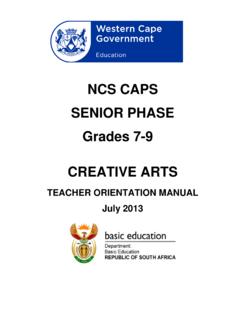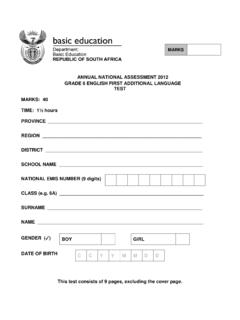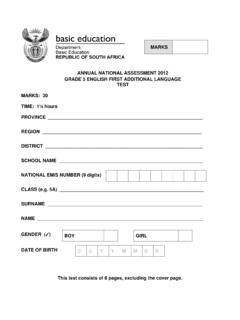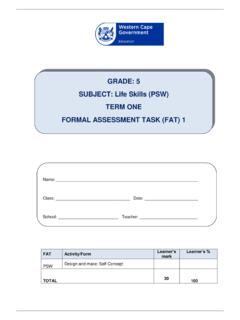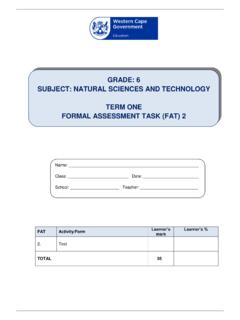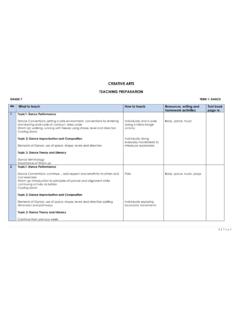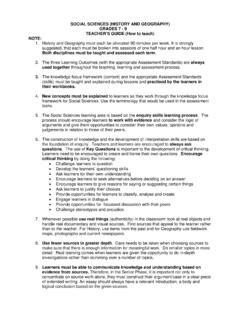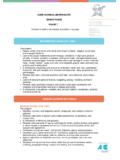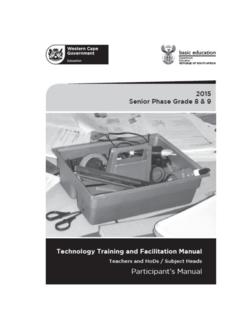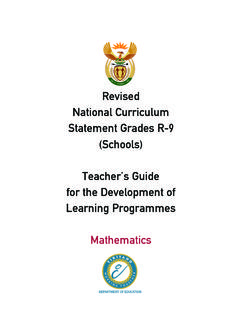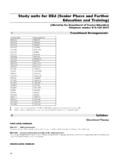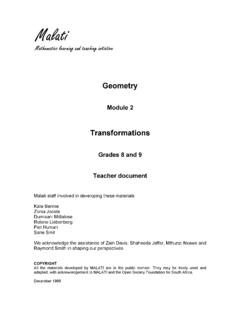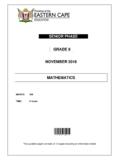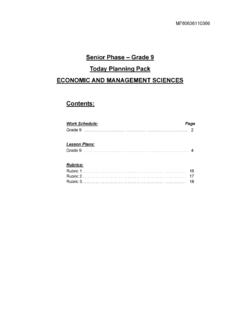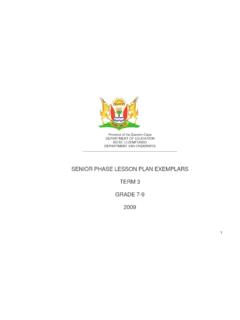Transcription of Phase Teacher’s Guide - Western Cape
1 senior Phase teacher s GuideGrade9 Technology CONTENT PAGE Introducing the teacher 's Guide 1 Developing technological capability 4 Glossary of learning area terminology 7 Selection of acceptable conventions for Technology 8 Technology: senior Phase Learning Area Programme 9 TERM 1 teacher 's Guide 12 TERM 2 teacher 's Guide 22 TERM 3 teacher 's Guide 29 TERM 4 teacher 's Guide 37 - 1 - senior Phase TECHNOLOGY grade 7-9 INTRODUCING THE teacher 'S Guide The teacher 's Guide gives week-by-week information on methodology, resources, assessment and integration with other learning areas and a vocabulary list.
2 METHODOLOGY Teaching and learning activities are suggested and should be used when developing lesson plans. Technology lends itself to teaching and learning activities that are set in a real-life context and it has a hands-on approach to teaching and learning. The concept of less teacher talk and more teacher and learner hands-on activities is balanced against the time available for teaching and learning. A balance must be maintained between talking to and learners engaging in activities that develop a deeper understanding. The work schedule follows Learning Outcome 1 as the methodology for teaching and learning in Technology. Learning Outcomes 2 and 3 are integrated with Learning Outcome 1. Experienced teachers can and should vary this teaching methodology. The grid below illustrates a simple recipe for the teaching of technology. Activity Explanation Time allocation Assessment: Informal / Formal Case study (Investigate) Start by using a related context to determine prior knowledge and skills and to introduce new knowledge and skills relevant to the new project.
3 1 to 2 hours Teaching and learning activities (Investigate, design, make, evaluate, communicate) These are a number of activities that develop the knowledge and skills the learners will need to solve the problem. Times will vary, depending on the level of prior knowledge or the level of new knowledge and skills required. Project task (Technological Capability) The learners apply the knowledge and skills taught to solve the problem and present a practical model and a poster or project portfolio. This can be from 6 to 8 hours. The teacher must identify the informal and formal assessment activities. Informal assessment is used to assess learners during the activities when the skill or knowledge is being developed. A formal assessment task: An assignment, test and or project are used to assess the learner s ability to apply knowledge and skills learned. - 2 - NOTE: The work schedule promotes the parallel delivery of teaching and learning with the development of the project as the formal assessment task.
4 This allows for assessment of the project (capability task) to be spread during the term. RESOURCES The consumable and non-consumable resources listed in the work schedule are offered as a Guide to support the teaching and learning process. Learners are expected to engage with the curriculum and, were possible, with resources that will support hands-on activities in the classroom. Schools must provide a budget for technology to purchase relevant consumable and non-consumable resources. All tools and equipment must be listed in the learning area inventory and a system developed to make these available to all technology classes. The provincial technology website provides a list of suggested materials and tools for the senior Phase . The following reference books were used when developing the work schedule and teacher 's Guide and offer valuable insight into the technological knowledge and skills addressed within the assessment standards. All the books are available from EDULIS.
5 1. Collins. Craft, Design and Technology: Design and Communication. Collins Education, 1988. 2. Dunn, Stewart. An Introduction to Craft Design and Technology. Bell & Hyman, 1986. 3. Garratt, James. Design and Technology. Cambridge University Press, 1991 4. Good, Keith. Starting CDT. Oxford, Heinemann, 1989. 5. Hewitt, T & Bateman R. Steps in Technology. Hutchinson Education, 1989. 6. Jordan, Malcolm. Creative Design & Technology. Longman, 1986. 7. Lee, Roy and Aldridge, John. Design Briefs: a complete introduction to Craft, Design and Technology. Cambridge University Press, 1989. 8. Richards, Roy. An Early Davis Start to Technology. Simon & Schuster, 1991. 9. Davis, Rick. Letts ultimate study Guide , Revise GCSE: Design and Technology. LETTS, 2005 The listed websites contain information on knowledge and skills that is relevant to the National Curriculum Statement for Technology in South Africa. A further resource is the Provincial Technology website.
6 It has valuable information that provides relevant information: INTEGRATION Integration across learning areas is effective when teaching more than one learning area within the same grade . Use integration across learning areas to manage the teaching and learning workload. Another form of integration is the grouping together of the learning outcomes within a learning area. The nature of technology lends itself to the integration of learning outcome 2 and 3 with learning outcome 1. The work schedule reflects this integration. The learning areas listed under integration are a Guide for possible integration. Languages must be seen by all teachers as automatic integration as learners are engaged in reading, writing and speaking using the technology context for the development of literacy. The integration with languages allows all teachers to support the literacy development of all learners. The Natural Sciences learning area also has a direct link to Technology, with its process skills approach to teaching and knowledge content areas.
7 Assessment across learning areas within a formal task needs specialist attention. It is not recommended that a technology teacher assesses a task based on criteria from another learning area, unless the teacher is responsible for teaching both learning areas or it is a planned process. - 3 - ASSESSMENT Continuous assessment Continuous assessment involves the assessment of activities that are undertaken throughout the year using different kinds of assessment forms, methods and tools. Informal assessment Daily assessment activities provide learners with an opportunity to develop skills, knowledge and values required to complete the formal tasks in the programme of assessment. Examples of daily assessment activities are the following: Worksheets, class discussions, question and answer sessions, responding to texts or pictures, using kits for building, making mock-ups (models or prototypes), homework tasks, completing crosswords, identify components or systems or processes, field trips, drawing or sketching, non-standardised class tests, notes in workbook / file.
8 Formal assessment Learners engage in one formal assessment task per term. The formal programme of assessment uses projects, assignments, case studies and tests or exams as appropriate forms of assessment. Learners will engage in a project for teaching and learning in each term. However, the assessment of the project (technological capability) is planned for term 2 and 3 only. It is recommended that the project portfolio for term 2 reflects a concentrated approach to what is expected in a portfolio; four to eight A4 sides could be sufficient. The project portfolio presented for the third term should be a more comprehensive presentation of the technological processes. A project is divided into a number of activities as the formal assessment is planned to run parallel to teaching and learning. This will reduce the workload at the end of the term. FORMAL PROGRAMME OF ASSESSMENT: grade 7 grade 8 grade 9 Form of assessment Week Form of assessment Week Form of assessment Week TERM 1 TASK 1 Case study Assignment Practical 5 7 8/9 Assignment Case study Test 5 6 10 Assignment Test 5 10 TERM 2 TASK 2 Project Exam 2+ 9 Project Exam 2+ 9 Project Exam 3+ 9 TERM 3 TASK 3 Project Test 2+ 10 Project Test 1+ 10 Project Test 1+ 10 TERM 4 TASK 4 Communication Practical Exam 5 6/7 9 Investigation Design & communicate Exam 2 5 8 National external assessment 7+ NOTE: Tests and exams must be completed within the context of the school s assessment plan.
9 The inclusion of the exam or test on the programme of assessment above is to ensure that it is included. VOCABULARY These words must be used during the teaching, learning and assessment process. The development of technological literacy can be promoted by using the vocabulary during teaching and learning on flashcards. They are sequenced in the order as they appear in the assessment standards as integrated in the work schedule. The glossary provided explains some of the often-misunderstood technical process words. You are encouraged to use the glossaries found in textbooks and any technical dictionary for a detailed explanation of the key words. - 4 - DEVELOPING TECHNOLOGICAL CAPABILITY (Learning Outcome 1) Analyzing a scenario and investigating Bubble charts or spider diagrams are suitable methods used to present the analyses of a scenario. The following questions will help identify the key areas that may require more investigation or research: What is the problem, need or opportunity?
10 Who will use the solution? Where will it be used? When will it be used? How will it be used? Why is it needed? What do similar solutions looks like? This analytical process supports the development of literacy skills within technology. It can be used to support the literacy programme's reading half-hour. The development and use of flash cads of key knowledge and process skills concepts will add to the development of technological literacy. Items on the bubble chart that are similar must be grouped together, with links shown. Research or practical investigation activities become the method used to find answers to these questions. It is important to draw conclusions from the investigation or research that will affect the design solutions. Writing a design brief The design brief must be a short statement of the problem to be solved and not a description of the solution. An open brief allows for more creativity than a closed brief, which describes a solution.
